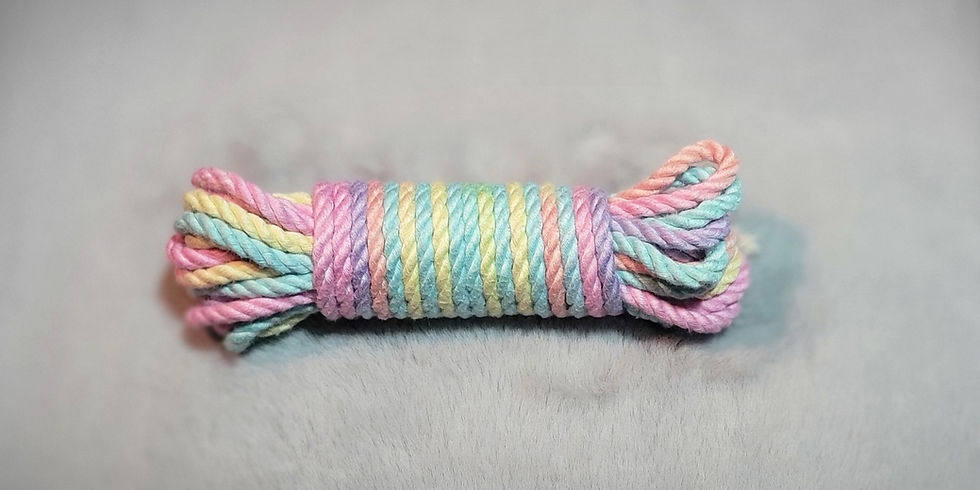The Tapestry of Shibari: A Journey Through Styles
- Joshua Thomas
- Dec 28, 2024
- 3 min read
Imagine a quiet room where the soft sound of rope moving through hands fills the air. Light streams through the windows, casting intricate shadows on the floor. Two people are fully immersed in the art of shibari, their movements deliberate and full of intention. Every knot tells a story, every loop and pull revealing connection and creativity.
Shibari is not a singular experience. It is a collection of styles, each offering something unique. Like a painter selecting colors or a dancer choosing steps, shibari artists work within a variety of approaches to create something meaningful and personal. Let us explore these styles together as pieces of an evolving story.
The Roots: Traditional Shibari
The journey begins with traditional shibari, also known as kinbaku. This style feels like stepping into a piece of living history. Each knot is placed with care, every pattern reflecting a deep respect for Japanese aesthetics and philosophy.
In traditional shibari, patterns such as the takate-kote or the karada are used to create a sense of harmony. The ropes often frame the body asymmetrically, reflecting the idea of finding beauty in imperfection. This style is not just about technique. It is about emotion and storytelling, where every tie deepens the connection between the rigger, the model, and the art itself.
The Flourish: Decorative Shibari
Next comes decorative shibari, a style that embraces boldness and visual creativity. Here, the ropes are not just tools of restraint but brushes in the hands of an artist. This approach transforms the body into a living canvas, where every twist and weave adds to the overall composition.
In decorative shibari, colorful ropes often come into play, creating designs that might evoke cherry blossoms, flowing water, or geometric shapes. It is not about how tightly the ties hold but how they capture the viewer’s imagination. This style thrives on beauty and expression, perfect for performances or photoshoots.
The Flight: Suspension Shibari
Suspension shibari takes the art form to another level, quite literally. This style involves lifting the model off the ground using carefully placed ropes. It is a dance of precision and balance, where the interplay of tension and counterweight creates breathtaking displays.
Imagine a model gracefully hanging midair, their form perfectly balanced by the ropes that hold them. The rigger becomes both artist and engineer, ensuring not only the aesthetic appeal but also the safety of the ties. Suspension is a dynamic and challenging style that showcases the power and beauty of shibari.
The Whisper: Minimalist Shibari
Minimalist shibari offers a quieter, more introspective experience. With only a single rope or two, this style focuses on simplicity and intention. It is about stripping away the complexity to highlight the purity of connection.
Picture a single column tie wrapped gently around a wrist or ankle. The simplicity draws attention to the body’s natural curves and contours. This approach invites mindfulness, allowing the participants to focus on the energy shared between them rather than the complexity of the patterns.
The Heart: Therapeutic Shibari
Therapeutic shibari turns rope into a tool for healing. This style is less about art or restraint and more about creating a sense of comfort and presence. The ties are gentle and nurturing, designed to ground and soothe rather than restrict.
Imagine a model lying still as soft rope is wrapped around them with care. Their breathing slows, their mind quiets, and the world outside fades into the background. Therapeutic shibari can be a deeply emotional experience, offering a space for release, self-discovery, and renewal.
The Innovation: Fusion Shibari
Fusion shibari blends elements from multiple styles, often incorporating influences from contemporary art, Western bondage, or even performance theater. This style is about pushing boundaries and experimenting with new ideas.
Riggers might use unconventional materials like fabric or chains alongside traditional ropes. They may mix intricate patterns with minimalist ties or add props and costumes for dramatic effect. Fusion shibari is as unique as the people creating it, allowing for endless possibilities and personalization.
Shibari is more than knots and patterns. It is a language of expression, connection, and creativity. Each style tells its own story, offering something different to those who practice it. Whether you are drawn to the elegance of tradition, the boldness of decoration, or the healing power of therapeutic ties, there is a place for everyone in the world of shibari.
At Bound by Elegance Shibari, we embrace the diversity of this art form and invite you to explore its many facets. Find the style that speaks to you, and together, we will build connections, one knot at a time.





Comments